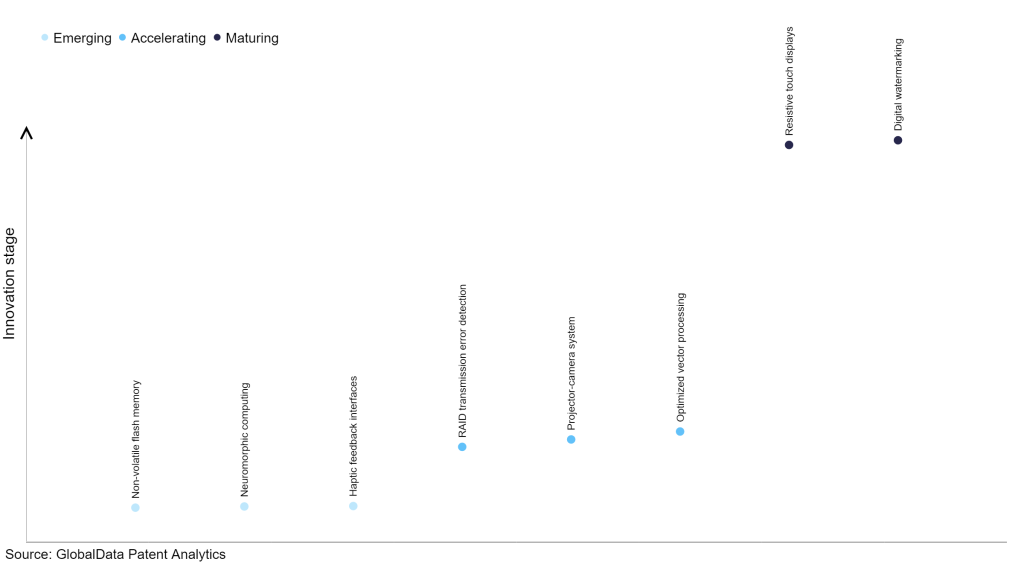The technology industry continues to be a hotbed of patent innovation. Activity is driven by the escalating demand for reliable and secure computing solutions, especially in sectors where data integrity is non-negotiable, the proliferation of data-intensive applications, increasing server deployments, and growing concerns about data security and accuracy. The growing importance of technologies such as advanced error correction algorithms, memory controllers, and integrated ECC features within memory modules, further fuel the demand for ECC memory. In the last three years alone, there have been over 1.5 million patents filed and granted in the technology industry, according to GlobalData’s report on Innovation in technology: ECC memory. Buy the report here.
However, not all innovations are equal and nor do they follow a constant upward trend. Instead, their evolution takes the form of an S-shaped curve that reflects their typical lifecycle from early emergence to accelerating adoption, before finally stabilizing and reaching maturity.
Identifying where a particular innovation is on this journey, especially those that are in the emerging and accelerating stages, is essential for understanding their current level of adoption and the likely future trajectory and impact they will have.
185+ innovations will shape the technology industry
According to GlobalData’s Technology Foresights, which plots the S-curve for the technology industry using innovation intensity models built on over 1.6 million patents, there are 185+ innovation areas that will shape the future of the industry.
Within the emerging innovation stage, non-volatile flash memory, neuromorphic computing, and haptic feedback interfaces are disruptive technologies that are in the early stages of application and should be tracked closely. RAID transmission error detection, projector-camera system, and optimized vector processing are some of the accelerating innovation areas, where adoption has been steadily increasing. Among maturing innovation areas are resistive touch displays and digital watermarking, which are now well established in the industry.
Innovation S-curve for the technology industry

ECC memory is a key innovation area in technology
Error correction code (ECC) memory is a form of computer memory designed to detect and rectify errors that might occur during data storage and transfer. By employing supplementary bits for data validation, ECC memory introduces redundancy, enabling it to identify and rectify data inaccuracies. This, in turn, minimizes the likelihood of data corruption and enhances overall data dependability.
GlobalData’s analysis also uncovers the companies at the forefront of each innovation area and assesses the potential reach and impact of their patenting activity across different applications and geographies. According to GlobalData, there are 215+ companies, spanning technology vendors, established technology companies, and up-and-coming start-ups engaged in the development and application of ECC memory.
Key players in ECC memory – a disruptive innovation in the technology industry
‘Application diversity’ measures the number of applications identified for each patent. It broadly splits companies into either ‘niche’ or ‘diversified’ innovators.
‘Geographic reach’ refers to the number of countries each patent is registered in. It reflects the breadth of geographic application intended, ranging from ‘global’ to ‘local’.
Patent volumes related to ECC memory
| Company | Total patents (2010 - 2022) | Premium intelligence on the world's largest companies |
| Silicon Motion Technology | 353 | Unlock Company Profile |
| Qualcomm | 91 | Unlock Company Profile |
| VIA Technologies | 28 | Unlock Company Profile |
| Texas Instruments | 135 | Unlock Company Profile |
| Rambus | 68 | Unlock Company Profile |
| Apple | 66 | Unlock Company Profile |
| SK Square | 21 | Unlock Company Profile |
| NXP Semiconductors | 77 | Unlock Company Profile |
| Taiwan Semiconductor Manufacturing | 75 | Unlock Company Profile |
| Alibaba Group | 33 | Unlock Company Profile |
| Hitachi | 48 | Unlock Company Profile |
| Phison Electronics | 162 | Unlock Company Profile |
| Renesas Electronics | 38 | Unlock Company Profile |
| Advanced Micro Devices | 49 | Unlock Company Profile |
| Winbond Electronics | 212 | Unlock Company Profile |
| Infineon Technologies | 74 | Unlock Company Profile |
| Sony Group | 32 | Unlock Company Profile |
| IBM | 284 | Unlock Company Profile |
| STMicroelectronics | 46 | Unlock Company Profile |
| Macronix International | 71 | Unlock Company Profile |
| Broadcom | 146 | Unlock Company Profile |
| Toshiba | 538 | Unlock Company Profile |
| Intel | 477 | Unlock Company Profile |
| Pure Storage | 50 | Unlock Company Profile |
| Micron Technology | 1801 | Unlock Company Profile |
| Semiconductor Energy Laboratory | 31 | Unlock Company Profile |
| Kioxia | 124 | Unlock Company Profile |
| ChangXin Memory Technologies | 26 | Unlock Company Profile |
| Sandisk Technologies | 33 | Unlock Company Profile |
| Via Alliance Semiconductor | 32 | Unlock Company Profile |
| Ace Kai Hynix | 114 | Unlock Company Profile |
Source: GlobalData Patent Analytics
Among the companies innovating in ECC memory, Micron Technology is one of the leading patents filers. The company’s patents are aimed at describing devices and methods for executing copy-back operations within a memory device. The identification of a trigger to initiate a copy-back operation pertaining to a specific data segment stored in the memory device is the initial step. Subsequently, the memory device's circuitry reads the data segment at two distinct voltage levels within a defined read window, obtaining a primary set of bits and a secondary set of bits, respectively. These sets of bits, which should ordinarily match, are then compared to assess if any disparity exceeds a predefined threshold. In cases where such a discrepancy surpasses the threshold, error correction procedures are activated before finalizing the copy-back operation. Other prominent patent filers in the space include SK Square and Samsung Group.
In terms of application diversity, Micron Technology leads the pack, while SK Square and Samsung Group stood in second and third positions, respectively. By means of geographic reach, Acacia Research held the top position, followed by Via Alliance Semiconductor and Texas Instruments.
ECC (Error-Correcting Code) memory plays a crucial role in ensuring data accuracy and reliability in computing systems. It detects and corrects errors that may occur during data storage and processing, especially in critical applications like servers, medical equipment, and aerospace systems. This capability is vital for maintaining the integrity of mission-critical operations. ECC memory is instrumental in safeguarding against potential data corruption, making it an essential component in environments where precision and accuracy are paramount.
To further understand the key themes and technologies disrupting the technology industry, access GlobalData’s latest thematic research report on Technology.
Data Insights
From

The gold standard of business intelligence.
Blending expert knowledge with cutting-edge technology, GlobalData’s unrivalled proprietary data will enable you to decode what’s happening in your market. You can make better informed decisions and gain a future-proof advantage over your competitors.







